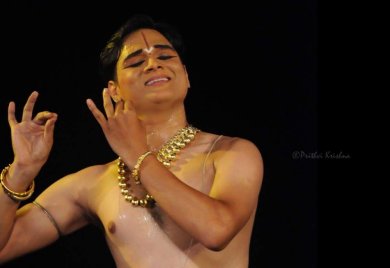
|   |

|   |
 e-mail: leelakaverivenkat@gmail.com Promising youngsters in Music Academy's endowment program February 4, 2020 K. Chandrasekharan (1904-1988) could be called a renaissance man, with many talents. An avid Sanskrit scholar, for years Secretary and Trustee for the Madras Sanskrit College and Ayurvedic College and Dispensary, Secretary of Kuppuswamy Research Institute, Vice President of the Music Academy and Member Vice-President of Kalakshetra, he was a prolific writer in English and Tamil, Tagore professor of Humanities, a sensitive portraitist in miniature and above all an ardent rasika of dance and music. It was in the thirties that under the banner of Sahridaya, he started providing a platform for young artists. And very correctly the annual endowment programme Bharatanatya Manjari presented by the Music Academy in his memory presents well selected young dancers, many of whom have become part of the Academy's major dance festival today. This year's Bharatanatya Manjari presented two young dancers, Yogesh Kumar followed by Shreema Upadhyaya, coincidentally both from Bangalore.  Yogesh Kumar Currently under the guidance of Guru Sathyanarayana Raju, Yogesh Kumar who runs his own school for training youngsters, Narthana Yoga Foundation Trust, started his training under K. Brunda and would seem to have been under more than two teachers. The Ashtaragamalika Varnam, "Sami ninne kori naanura" wherein the nayika expresses her overwhelming love (premameera) for Tanjapuriwasa, saw an expressive dancer whose abhinaya ideas seemed to be drawn from several sources. For instance he showed the devotee's inability to see the face of the beloved Lord because of the squatting Nandi hiding the view - and what followed was more like a sequence from "Oru maadu Paduthirukkudhe." The nayika expressing her love for the god would seem to be differently placed from the 'low born' denied temple entry. But the dancer's uncomplicated teermanams were performed with a clean profile and his mobile face did not lack for expression. Powering the dance was the mellifluous vocal support of G. Srikanth. Nattuvangam was by Sneha Narayan and mridangam support had Harsha Samaga and on flute was Mahesh Swamy. The Purandaradasa Hanuman item in Poorvikalyani was very well done - much in the manner of his guru whose portrayal of this deity is particularly powerful.  Shreema Upadhyaya Even as she made her entry, one could see Shreema Upadhyaya's exceptional quality. The very start with the Muruga Kavutvam showed her Guru Praveen Kumar's rare choreographic artistry. Sung in Shanmukhapriya, the dance arrangement in a manner where every other line was sung and the in-between lines were danced only to the sound of 'sollus' with the dancer's electric movements made this opening number very special. The varnam, a Papanasam Sivan composition in Dhanyasi, "Nee inda maayam" wherein the Nayika asks the Lord of Madurai, if it is fair that he should play tricks with her when assailed by Manmatha's arrows, with her overwhelming love for him. Addressing this killer of Mura as "Ayar kula deepame" (Light of the 1000 families of the Yadavas), she yearns for his love. With her Guru Praveen's nattuvangam lead, and Raghuram's vocal support, with Lingaraj on the mridangam and Mahesh on flute, Shreema's rendition of both the interpretative and the rhythmic parts showed not just impeccable technique and dance profile, but a fine sense of stage space and innate feel for abhinaya. Lyricism and music of Kanaka Dasa's "Baro Krishnaiyya" full of a yearning quality inviting Krishna to the home, was followed by the concluding item of a Tillana composition by Shatavadani Ganesh in the raga Sumanesaranjani. If she continues to evolve under Praveen taking such pains with his teaching, Shreema Updhyaya looks to be a dancer with a fine future.  Writing on the dance scene for the last forty years, Leela Venkataraman's incisive comments on performances of all dance forms, participation in dance discussions both in India and abroad, and as a regular contributor to Hindu Friday Review, journals like Sruti and Nartanam, makes her voice respected for its balanced critiquing. She is the author of several books like Indian Classical dance: Tradition in Transition, Classical Dance in India and Indian Classical dance: The Renaissance and Beyond. Post your comments Please provide your name and email id when you use the Anonymous profile in the blog to post a comment. All appropriate comments posted with name and email id in the blog will also be featured in the site. |